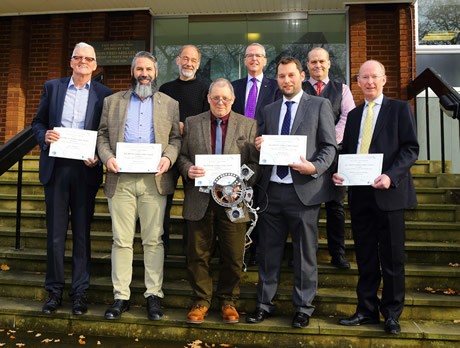United Kingdom News
AMPTHILL, BEDFORDSHIRE, 12 DECEMBER 2017 – Engineers from Bedfordshire technology business Lockheed Martin UK have been honoured for their work on a pioneering space project.
The Beagle 2 Mars Mission project team was recognised by the Arthur C Clarke Foundation for ‘outstanding achievement’. Engineers from Lockheed Martin’s Ampthill site were presented with certificates last week for their work on a crucial part of the mission.
The story of Beagle 2 has captured the imagination since its launch nearly 14 years ago. In December 2003 the Beagle 2 probe separated from spacecraft Mars Express Orbiter using a Spin-Up Eject Mechanism (SUEM) designed by the Ampthill team. The SUEM was to support Beagle 2 during its launch from Mars Express and its transfer to the Red Planet.
On landing, the probe was supposed to open like a clamshell and deploy solar panels and instruments that would look for signs of life on Mars.
But nothing more was heard from Beagle 2 after it was successfully ejected from its mothership on Christmas Day 2003. It plummeted through the Martian atmosphere at more than 20,000kph and was never heard of again. The Ampthill-designed SUEM the last known thing to work on the mission.
Speculation for the failure included the probe missing the planet completely, burning up on entry, running into poor weather, or hitting the ground too hard.
Beagle 2 was presumed lost until – more than a decade after the launch – the missing probe was located in images from NASA’s Mars Reconnaissance Orbiter.
It was discovered that Beagle 2 had indeed landed on the surface of Mars on 25 December 2003 and that it had only missed its intended target by a couple of miles. At least three of the four solar panels had opened, and it could have been the inactivation of the final panel in the clamshell that resulted in the main antenna not being exposed, and prevented communication.
Professor Steve Burnage, who led the Ampthill team at the time of the mission but has since retired, joined his former colleagues at the reception where they were presented with their certificates by Beagle 2 chief engineer Dr Jim Clemmet.
Professor Burnage said: “When Beagle 2 was discovered we were elated that the mission was far more of a success than we had learned to live with over the years, but it was frustrating that it was probably only one malfunctioning panel that led to failure. We were so close to being part of a historic mission.
“To find out after all this time that after its 50 million km journey, the probe landed within 5km of its target, and that the original calculations were spot on after all, was hugely satisfying. To have our achievement recognised as part of the whole Beagle 2 team is a great honour.”
The Beagle 2 team was awarded the 2015 Sir Arthur Clarke Award for Space Achievement in Industry/Project Team by the Arthur C Clarke Foundation. The award is made for significant or outstanding achievement by a team in all space activities.


